The Krishna Temple, also known as the Balakrishna Temple, is situated in Hampi, Karnataka, India, and is part of the Group of Monuments that is listed as a UNESCO World Heritage Site. This temple dedicated to the infant form of Lord Krishna, Balakrishna. It stands as an architectural gem, bearing testimony to the artistic grandeur of the Vijayanagara Empire. This magnificent structure draws visitors from around the world, enamored by its beauty and historical significance. The temple is located next to the main road leading to Hampi. At a distance of 520 meters[1] from Hampi Bus Stand.
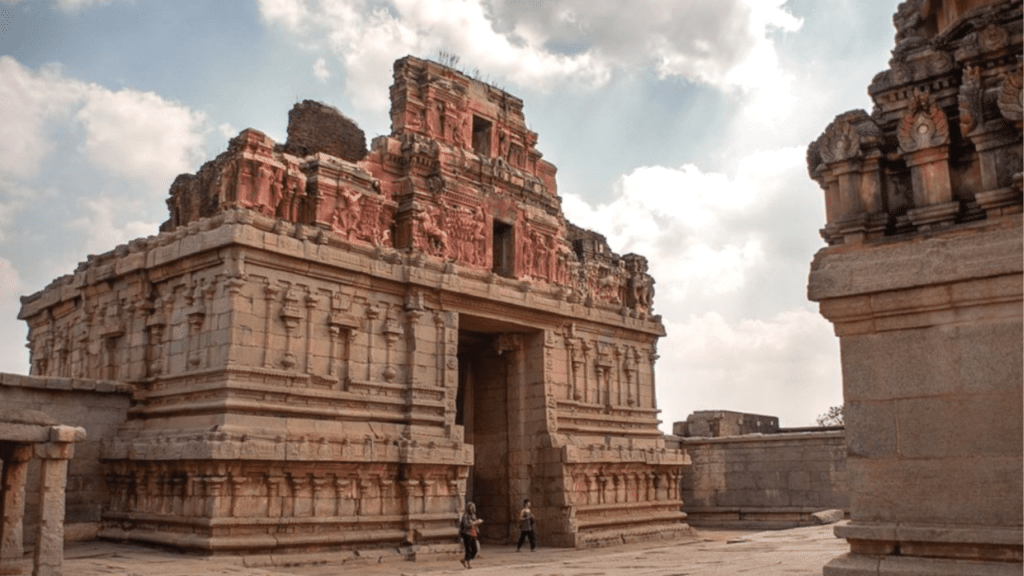
Table of Contents:-
Visiting the Krishna Temple allows you to immerse yourself in the rich history, religious fervor, and architectural splendor of Hampi. it’s stands as a testimony to the cultural heritage and spiritual legacy of Hampi. It offers a glimpse into the devotion and artistic brilliance of a bygone era while continuing to inspire and captivate visitors with its timeless beauty.
Quick Facts
- Timing: Daylight Hours Only
- Entry Fee: No entry fee required
- Photography: Allowed
- Location: Google Maps
- Must-see Things
A Victory Celebration
King Krishnadevaraya of the Vijayanagara empire built the temple to celebrate his victory over the eastern kingdom of Udayagiri (present-day Orissa). The Gajapatis ruled over Bengal, the Andhra region, and Odisha as part of their vast empire. When Krishna Deva Raya won at Ummatur, he gained the confidence to expand his campaign into the coastal Andhra region controlled by Gajapati Raja Prataparudra Deva. In 1512, the Vijayanagar army laid siege to the Udayagiri fort, where the Gajapati army eventually succumbed due to starvation after a year-long campaign.

Idol of Balakrishna
The inscription on the slab set up inside the temple’s compound records that in 1513 CE[2] (1515 CE)[3] Krishnadevaraya installed an idol of Balakrishna brought from Udayagiri. This original idol is now displayed at the Government Museum in Egmore, Chennai.[4]
The statue depicts Balakrishna seated, with the left leg resting on the seat and the right leg hanging down. Unfortunately, both hands are broken and missing, except for the fingers of the left hand. The hair is tied in a knot over the head, and the earrings (kundalas) resemble small conch shells (sankhas). The forehead bears the sandal paste mark, a characteristic feature of this period.
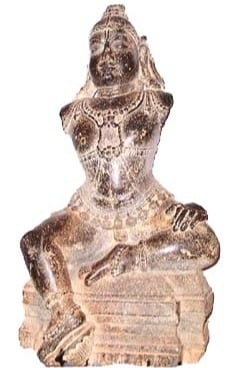
Exploring the Temple Complex
The temple is enclosed by two concentric walls. The main temple, subsidiary shrines, pavilions, and other structures are laid out in the rectangular inner enclosure. The main temple consists of garbhagriha (sanctum), antarala (aritechamber) surrounded by pradakshinapatha (circumambulatory passage), rangamandapa (pillared hall) and mahamandapa (large pillared nall) and a pavilion of later addition.
The pillars of Rangamandapa are adorned with various Hindu deities and mythological stories. This enclosure also has subsidiary shrines and a small mandapa All these structures are enclosed in a prakara (enclosure) wall with three gateways on the east, north and south. The inner face of the prakara wall is lined with coldinnade, which has a walled kitchen and two mandapas.
The temple is right by the main road to Hampi. Across the road from the temple, you’ll notice a small pavilion with a large rectangular structure carved out of a huge boulder. This structure has a small opening on top in which devotees and visitors used to offer donations.

Eastern Entrance Tower
The main tower in the east is a great example of Vijayanagara architecture. It has lots of carvings on it. Even though only a part of the tower’s top part is left, it still shows detailed figures of warriors with shields, energetic horses, and elephants. On the sides of the entrance, there are beautiful sculptures of celestial dancers standing on imaginary animals and holding scrolls with pictures of different forms of Lord Vishnu.
The western side of the east gopura has depiction of Krishnadevaraya’s Udayagiri expedition. Another noteworthy representation is that of lunar eclipse on the lidtel of the east gopura entrance. At the entrance’s top, there’s a special carving showing a rabbit on the moon with two snakes moving towards it. This depicts a solar eclipse, with Rahu and Ketu chasing the moon to swallow it.

Krishna Bazaar
To visit Krishna Bazaar, simply cross the main road to Hampi after exploring the Krishna Temple. Additionally, you can enjoy a great aerial view of the Krishna Bazaar by climbing Matunga Hill.
Krishna Bazaar is one of the recently excavated sites of Hampi. The inscription mentions it as the Chariot Street of Lord Krishna. The idol of Krishna used to be placed in the chariot for a procession during festivities and celebrations. Krishna Bazaar was not only a centre cultural and religious practices but also a major marketplace of the metropolis. Krishna Bazaar is over half a kilometre in length and about 49.5 metres in width.There are long rows of pavilions along the Bazaar Streeton 3 feet high adhistana (platform).
Vijayanagara was famous for its trade. Chinese porcelain items were discovered near Krishna temple during the excavation. The 1545 C.E. inscription of the Sadashiva period mentions that tax was collectedon sold goods every Monday and one coin was collected from each shop. It is clear from the Achyutaraya’s inscription, that Krishna Bazaar was amajor market for grains.[5]

Pushkarini near Krishna Bazaar:
The sacred pushkarani (pond / tank) is located on the north east of this bazaar. A Pushkarini is a sacred water tank typically found near Hindu temples, serving various religious and ritualistic purposes. In the context of Hampi, the Krishna Bazaar Pushkarini likely served as a place for ritual purification before entering the nearby Krishna Temple or for ceremonial bathing during religious festivals.
During the rainy season, the Pushkarni is filled with water, replenished by rainfall. However, during the summer months, the water levels gradually decrease as a result of evaporation and lack of precipitation, eventually leading to the drying up of the tank.

Must-see things in Krishna Temple
When visiting the Krishna Temple in Hampi, there are several must-see things that you should explore and appreciate. Here are some of the highlights:
Ranga Mandapa (Pillared Hall):
Explore the Ranga Mandapa, the pillared hall of the temple. Marvel at the exquisite carvings on the pillars, which depict various mythological scenes and divine figures. The detailed craftsmanship is truly remarkable.
Eastern Gopuram:
The Eastern Gopuram of the Krishna Temple in Hampi stands tall, adorned with intricate carvings and sculptures that depict divine beings and mythological figures. As a symbol of the architectural grandeur of the Vijayanagara Empire, it serves as both a physical entryway and a spiritual gateway into the sacred realm of the temple.
Pushkarini (Stepped Tank):
Adjacent to the temple, you’ll find the Pushkarini, a stepped tank. Take a stroll around the tank and observe its architectural beauty. The tank was used for ceremonial purposes and adds to the overall charm of the temple complex.
Kannada inscriptions:
Kannada inscriptions are carved onto the walls of the Krishna Temple, while a large slab inside the courtyard narrates the tale of the temple’s construction and the victory it commemorates. These inscriptions are not mere decorations; they are valuable records offering a glimpse into the temple’s history, the reign of the commissioning king, and even details about social life during that period. Imagine these inscriptions coming alive, narrating the story of the temple’s creation or the king’s grand victories.
Krishna Bazaar:
Step out of the temple complex and onto the path leading towards the Hampi Bazaar. Take a detour here to explore the Krishna Bazaar, once a bustling marketplace lining the chariot street that led to the temple. Though largely buried over time, excavations have revealed the outlines of shops and pavilions. Imagine the vibrant atmosphere of this bygone era, filled with vendors selling wares and pilgrims stopping by for provisions. The Krishna Bazaar, though silent today, offers a glimpse into the temple’s role as a center of commerce and community life in its prime.
Carvings and Sculptures:
Pay attention to the detailed carvings and sculptures that adorn the walls and pillars of the temple. These depict episodes from the Mahabharata and stories from Krishna’s life. Take your time to appreciate the artistic skill and storytelling conveyed through these sculptures.
Surrounding Temple Structures:
While at the Krishna Temple, explore the surrounding temple structures and ruins. Hampi is known for its vast archaeological site, so take the opportunity to discover other nearby temples and architectural marvels that contribute to the historical significance of the area.
Cultural Performances:
Depending on the time of your visit, you might have the chance to witness cultural performances such as music, dance, or religious ceremonies that take place in or around the temple. These performances offer a deeper insight into the cultural traditions associated with the Krishna Temple.
Gallery:-




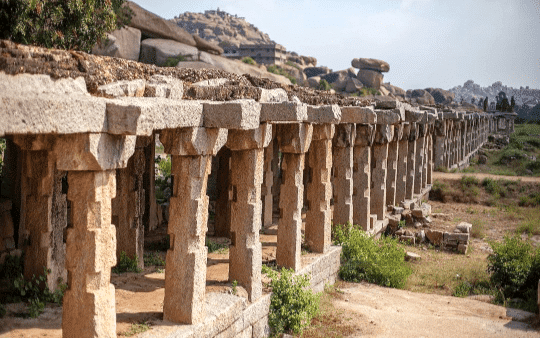
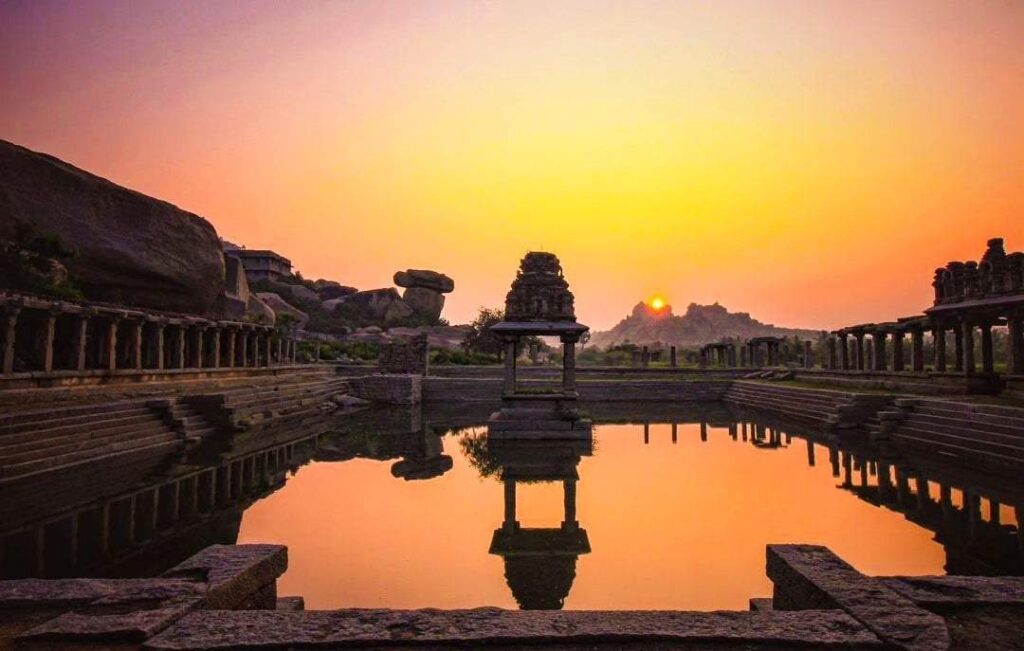


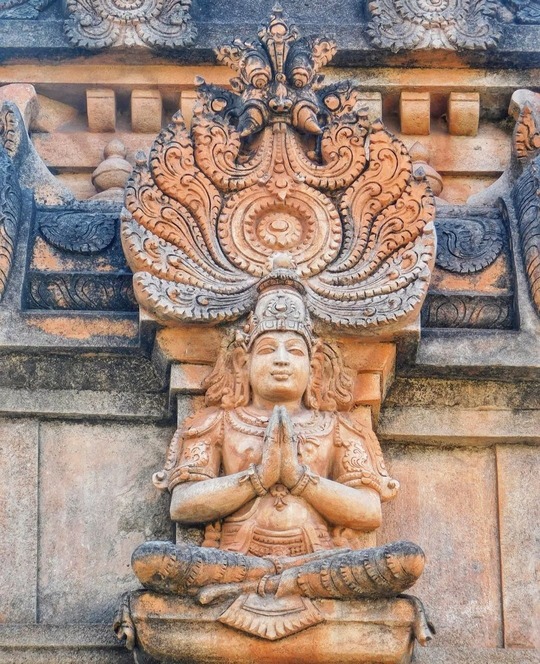



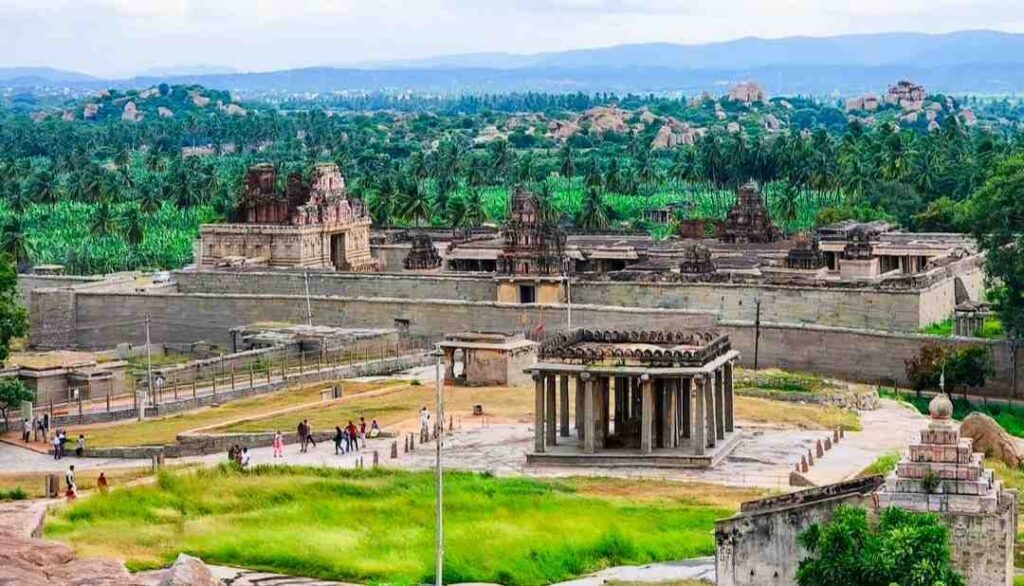
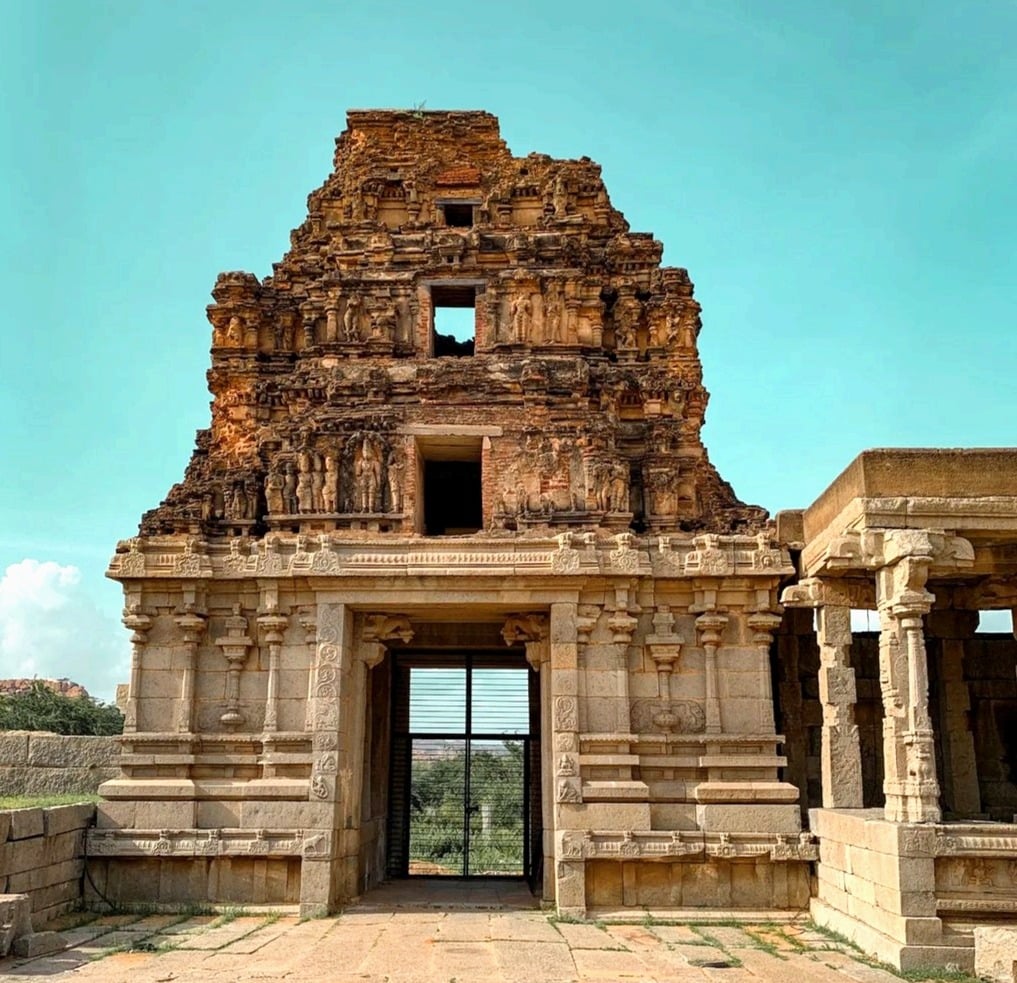




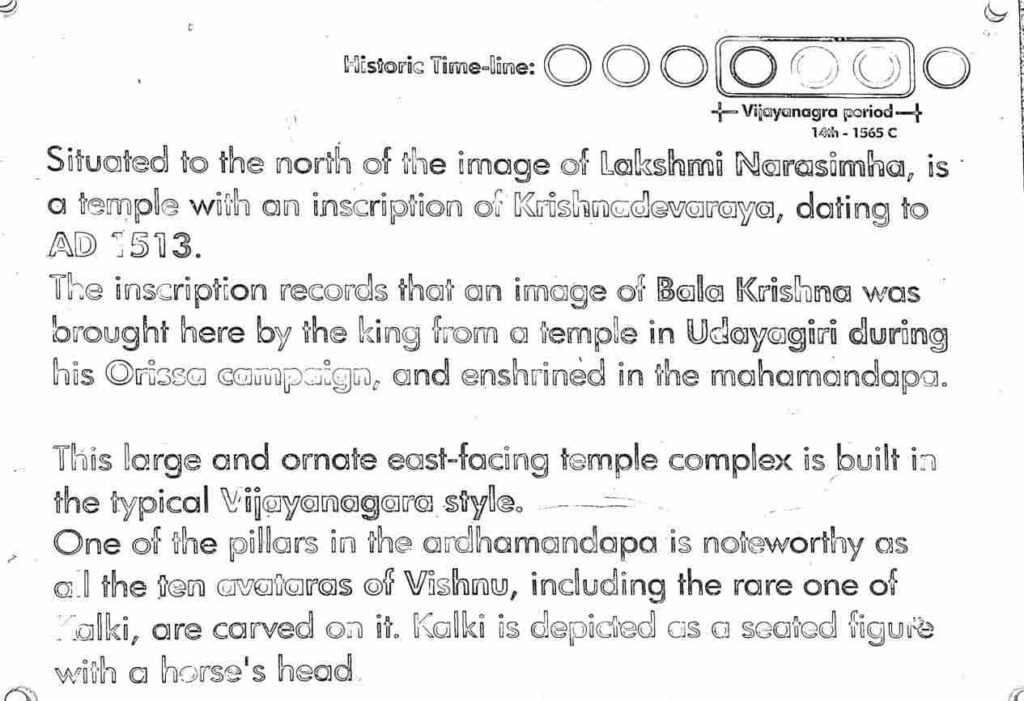
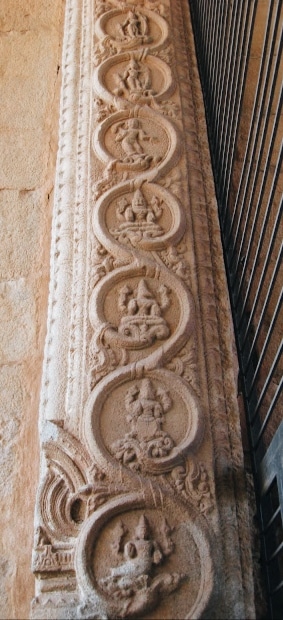
References:-
References from the Following Sources;
- ^[1] – Distance was calculated using Google Maps
- ^[2] – Temple history and construction year (1513 CE) were sourced from the ASI Information plaque located at the temple.
- ^[3] – Temple history and construction year (1515 CE) were sourced from the UNESCO World Heritage plaque located at the temple.
- ^[4] – Original Balakrishna idol is now displayed at the Government Museum in Egmore, Chennai
- ^[5] – Krishna Bazaar history were sourced from the Information plaque located at the Krishna Bazaar.
- Alexander Greenlaw’s photos from 1856 were sourced from the “Photo Exhibition” at Hampi organized by the Department of Archaeology Museums & Heritage, Government of Karnataka.